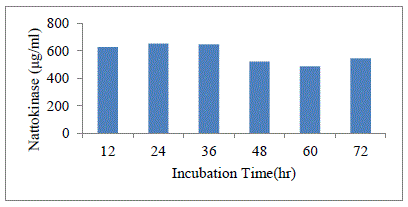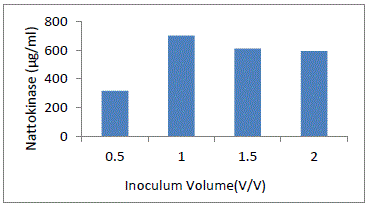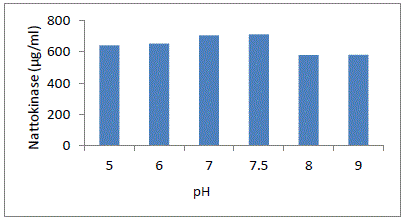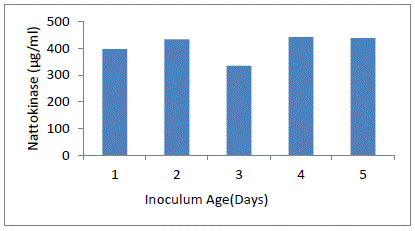ISSN ONLINE(2319-8753)PRINT(2347-6710)
ISSN ONLINE(2319-8753)PRINT(2347-6710)
Peddapalli Siva Rasagnya1 And Meena Vangalapati2
|
| Related article at Pubmed, Scholar Google |
Visit for more related articles at International Journal of Innovative Research in Science, Engineering and Technology
Nattokinase (NK) is one such thrombolytic enzyme. Nattokinase is an enzyme with strong fibrinolytic activity that can be used for preventing thrombolytic diseases. It is a serine protease class of enzyme. Nattokinase finds its application in medical industry widely. It provides health benefits like cure of hemorrhoids, Diabetes, Muscle spasms, poor healing, chronic inflammation, help improve blood clotting mechanism, improve blood circulation, blood viscosity etc,. In the present study, fermented soya bean powder is used as substrate for nattokinase production and the optimized parameters like incubation time-24hrs, inoculum volume-1ml, inoculum age-4th day and pH-7.5 that effect the production are optimized and the crude enzyme obtained was purified by using 2-phase liquid extraction technique
Keywords |
| Nattokinase, Natto, Bacillus subtilis, Fibrinolytic activity, Submerged fermentation, Extraction. |
INTRODUCTION |
| Nattokinase is an enzyme extracted and purified from a Japanese food called nattÃâ¦ÃÂ. NattÃâ¦Ã is made from fermented soybeans and has been eaten in Japan for many years. NattÃâ¦Ã is produced by fermentation by adding the bacterium Bacillus natto to soybeans. Nattokinase is produced by the bacterium acting on the soybeans [1]. While other soya foods contain enzymes, it is only the nattÃâ¦Ã preparation that contains the specific nattokinase enzyme [2]. In spite of its name, nattokinase is not a kinase enzyme, but a serine protease of the subtilisin family. It exhibits a strong fibrinolytic activity hence comes under fibrinolytic enzymes also [3][4]. Nattokinase may be potentially useful as a clot-buster and blood thinner, and is considered by some in the alternative medicine community as a possible adjunctive therapy in cardiovascular disease. There is some evidence for its effectiveness [5]. Possible side effects have been reported. In one case, a patient concurrently taking aspirin and 400 mg of nattokinase daily for seven consecutive days to prevent stroke suffered an acute cerebellar hemorrhage.[6]Nattokinase plays an essential role in removing blood clots in small capillaries where surgeries are a risk[7][8]. Uses as an alternative medicine Human clinical studies have demonstrated the ability of Nattokinase to decrease euglobin (clot) lysis time (ELT) up to 8 hours after oral intake of a dose of natto estimated at 6,000 fibrin degradation units (FU). In addition, euglobulin fibrinolytic activity (EFA; lysis area on a fibrin plate) was increased significantly up to12 hours following administration[9]. In addition to fibrinolytic activity, nattokinase has demonstrated the ability to reduce elevated blood pressure in human volunteers with hypertension. Nattokinase has also demonstrated the ability to inhibit platelet aggregation, reduce rouleaux formation in blood cells and decrease blood viscosity, heart diseases and Alzheimer’s disease. |
| Production of nattokinase includes strains of bacillus subtilis and soya beans as high yielding substrate. In the present work, soya bean powder has been selected as a substrate, which is commonly available. The production parameters are optimized and the enzyme is extracted by liquid-liquid extraction. |
MATERIALS AND METHODS |
| A. Organism: Bacillus subtilis NCIM 2724 |
| B. Growth medium: Nutrient agar medium: The selected species of organism were obtained from NCIM- Pune and are maintained on nutrient agar medium at 300C for 24hrs and preserved by sub-culturing every 4 weeks [10]. |
| C. Substrate used: Soya bean powder. |
| D. production medium: Soya bean powder-1gm, K2HPO4-2mg, MgSO4-1mg, Maltose-20mg, Yeast Extract-10mg, Glucose-2mg and make 1 litre Solution[11]. |
| E. Inoculum Preparation: 5 ml of distilled water is added to Bacillus subtilis NCIM 2724 containing slant and 1ml of the preparation is added 250ml of production medium. |
| F. Submerged Fermentation: 4.5 grams of production medium was taken in 250 ml Erlenmeyer conical flasks and to this 100ml of water was added. The contents were mixed thoroughly and autoclaved at 1210c for 15 min. After cooling the flasks to room temperature, they were inoculated with 1ml of 24 hr old culture strain under sterile conditions. Conical flasks were kept in rotatory shaking incubator at 150rpm for 24hrs under aseptic conditions. |
| G. Enzyme Separation: After incubation period, sample is collected into 2ml Eppendorf tubes and centrifuged at 3000rpm for 15minutes. The supernatant was used as enzyme source for Nattokinase assay. |
| H. Enzyme Assay: Nattokinase activity was estimated by Lowry’s method. 1ml of the enzyme solution was added to 5ml of reagent C (This is prepared by adding 1ml of reagent A (2% Na2CO3 in 0.1N NaOH) to 500ml of reagent B (5% CuSO4 in 1% Sodium Potassium Tartarate) and then incubated for 10mins. To this mixture add 0.5ml of 1 fold Folin Ciocilteaue reagent and the absorbance was read at 560nm. |
| I. Extraction of Enzyme: Enzyme is extracted from the crude sample by using liquid-liquid separation technique. |
| J. Partition coefficient: The ratio of concentrations of a compound in a mixture of two immiscible phases at equilibrium. |
| P = [XE] / [XR] |
| Where [XE]: Extract phase and [XR]: Raffinate phase |
| Hence these coefficients are a measure of the difference in solubility of the compound in these two phases. In medical practice, partition coefficients are useful for example in estimating distribution of drugs within the body. Pharmacology, consumer products, environmental, metallurgy and agrochemicals are applications of partition coefficient. |
RESULTS AND DISCUSSIONS |
| A. Effect of Process Parameters: |
| Nattokinase enzyme was produced using the soya bean powder by Bacillus subtilis NCIM 2724. The process parameters like incubation time, inoculum volume, inoculum age and pH were carried out and optimized. |
| 1) Effect of Incubation time: To determine the effect of incubation time on nattokinase production, the inoculated flask was incubated for 12, 24, 36, 48, 60, 72 hours. After incubation period the enzyme was extracted and assayed. Results as shown in Fig: 1 indicate that there was a steep increase in the nattokinase production with the increase in time. The maximum nattokinase production was found at 24 hours. The maximum nattokinase concentration was found to be 653μg/ml at 24 hours. |
 |
| 2) Effect of Inoculum Volume: The nature of inoculum as well as its size may affect the microbial process. To evaluate the affect of inoculum level on the Nattokinase production varying cell concentration were added to different flask. Different inoculum volumes of 0.5, 1.0, 1.5 and 2.0ml are added to the 100 ml production medium and incubated for 24 hours at temperature 300C in rotatory shaking incubator and the results obtained are shown in the Fig: 2. The maximum production was obtained at 1ml of Bacillus subtilis NCIM 2724 and the maximum nattokinase concentration was found to be 702μg/ml. |
 |
| 3) Effect of pH: pH strongly influences many enzymatic process and also transport of various components across the cell membrane, which in turn supports the cell growth and product production. To determine the effect of pH, different values of pH 5, 6, 6.5, 7, 7.5, 8 and 9 were maintained and flasks were incubated for 24 hours. The results thus obtained for different values of pH are shown in Fig: 3. The highest enzyme activity was recorded at pH 7.5 and it was found to be 712μg/ml. |
 |
| 4) Effect of Inoculum Age: Inoculum age plays an important role in the enzyme production. Bacillus subtilis NCIM 2724 culture was scraped into 5ml of water i.e. added to the slant and a uniform solution is prepared. Nutrient broth was prepared and taken in 5 flasks and to this 1ml of the uniform culture solution was added and each flask is incubated at 24hrs difference. This uniformly prepared culture is inoculated into production medium and incubated for 24hrs and maximum production was obtained from 4th day culture. The effect of different inoculum age is shown in Fig: 4. The highest nattokinase activity was found to be 442μg/ml. |
 |
| Under these optimized conditions the highest concentration of nattokinase was found to be 340 μg/ml. |
| B. Liquid-Liquid Extraction:Take 30ml of crude enzyme sample and add 30ml of pure Hexane in a separating funnel and shake it thoroughly for 30minutes and leave the mixture for 30 minutes undisturbed. After 1 hour of Extraction the two layers were separated. The concentration of Nattokinase in Extract and raffinate phase was found to be 610 and 240 μg/ml respectively. The partition coefficient was calculated from Table 1 and it was found to be 2.54 |
 |
CONCLUSIONS |
| Nattokinase is a potent fibrinolytic enzyme that can be obtained from fermented soybeans. It widely finds its applications in medical industry.It provides health benefits like cure of hemorrhoids, Diabetes, Muscle spasms, poor healing, chronic inflammation, help improve blood clotting mechanism, improve blood circulation, blood viscosity etc,. In the present study, fermented soya bean powder is used as substrate for nattokinase and production parameters like incubation time, inoculum volume, inoculum age and pH were studied. Maximum Nattokinase was observed at the incubation time 24hrs, pH-7.5, inoculum volume-1.0ml and inoculum age-4th day culture and it was found to be 310 μg/ml. The produced Nattokinase under optimum conditions is purified by using Liquid-Liquid Extraction and the partition coefficient was found to be 2.5. Hence Bacillus subtilisNCIM 2724 is a potent producer of Nattokinase enzyme when soybean is used as substrate. |
References |
|